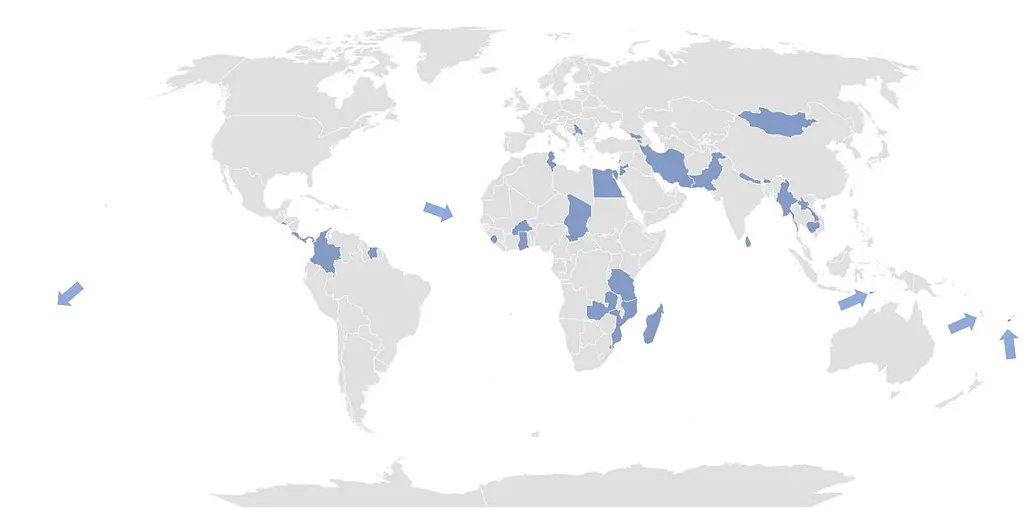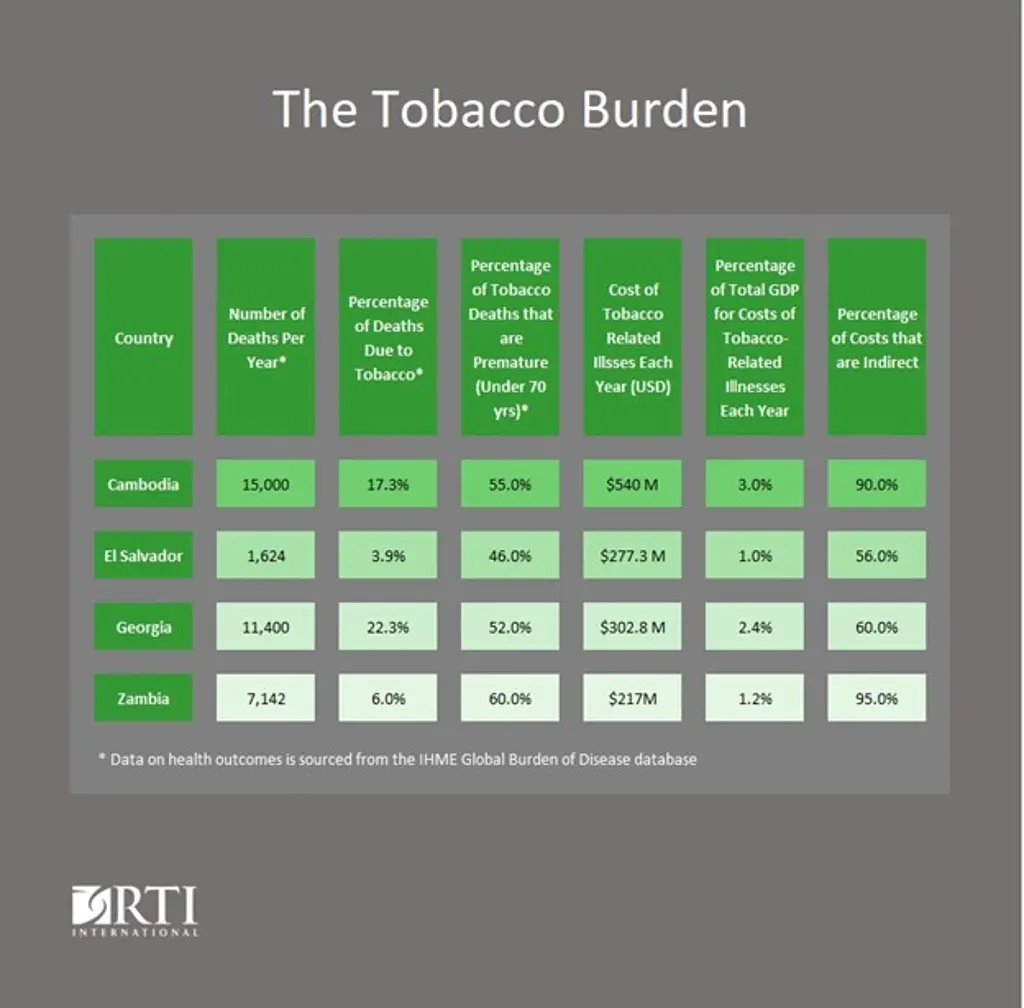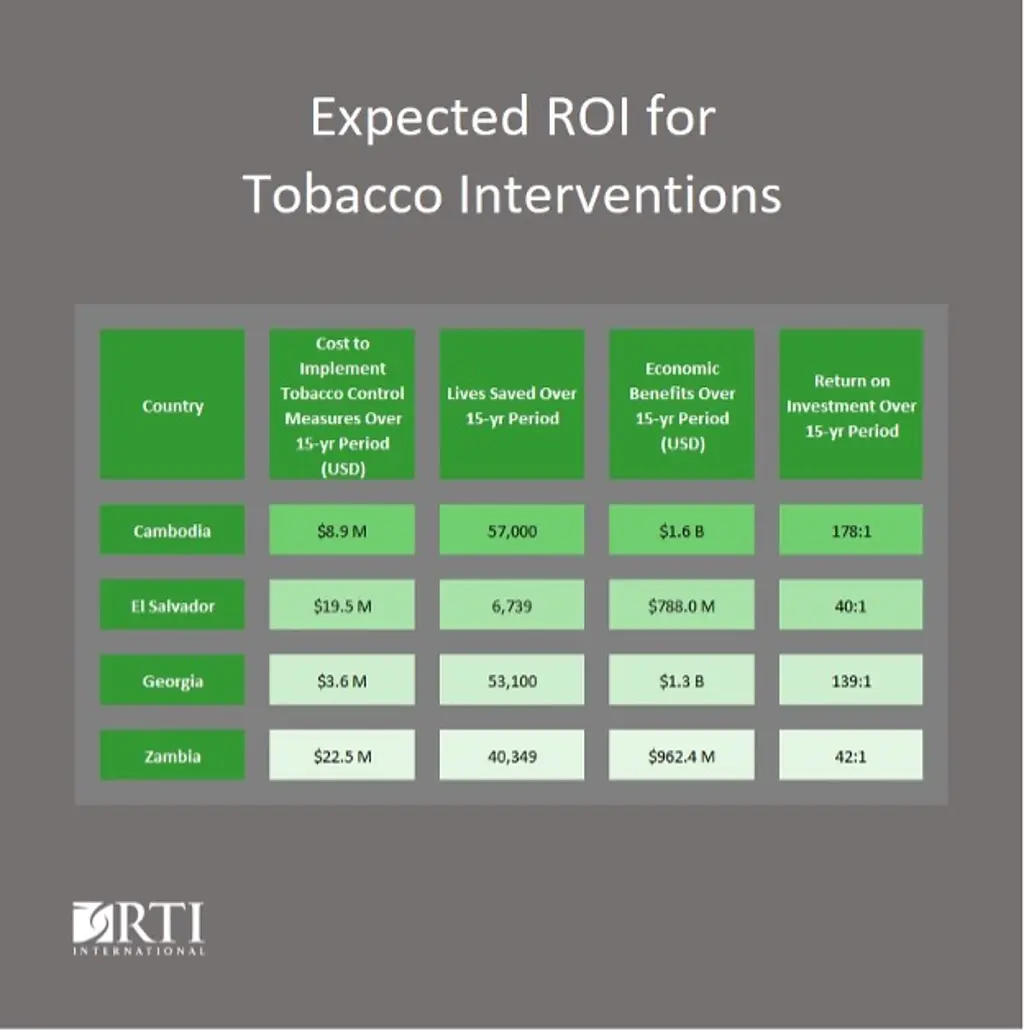Investment Cases for the Framework Convention on Tobacco Control
The tobacco epidemic is one of the biggest public health threats the world has ever faced, killing more than 8 million people each year through direct use and exposure to secondhand smoke. Tobacco is the second leading risk factor for death and contributes to the development of many noncommunicable diseases, including cancer, cardiovascular disease, and lung disease. Additionally, smoking increases risk associated with infectious diseases, such as COVID-19. According to WHO, smokers face a 40-50% higher risk of developing severe disease or death due to COVID-19 compared to non-smokers.
Many of the deaths attributable to tobacco use are considered premature, happening before people turn 70. About 80 percent of the world’s 1.3 billion smokers live in low- and middle-income countries (LMICs). Worldwide, healthcare expenditures to treat diseases caused by tobacco totaled nearly 6 percent of global health expenditures in 2012. Further, tobacco use can reduce productivity by permanently or temporarily removing individuals from the workforce due to poor health or premature death. The effects of tobacco use are most severe for lower income populations, for whom these health and economic losses related to medical expenses and workforce dropout can be devastating. Additionally, spending on tobacco can contribute to poverty by diverting income to purchase tobacco products rather than to fulfill other household needs.
To combat the tobacco epidemic, the World Health Organization (WHO) initiated the development of the Framework Convention on Tobacco Control (FCTC), which was adopted in February 2005. The FCTC is the first global public health treaty and aims to tackle causes of the tobacco epidemic and to address the social, economic, and environmental impacts. Currently, there are 182 Parties to the WHO FCTC, covering more than 90 percent of the world population.
While there have been remarkable achievements following the adoption of the FCTC, many countries are still working to implement tobacco control. The FCTC 2030 project is meant to strengthen tobacco control in LMICs by supporting governments to accelerate the implementation of FCTC measures in line with the 2030 Agenda for Sustainable Development. RTI has worked with the United Nations Development Programme (UNDP) and the Convention Secretariat of the WHO FCTC to prepare the case for investing in tobacco control in 36 countries that were selected to receive direct support under the FCTC 2030 project.
Our analyses have demonstrated that these tobacco control policies result in significant health and economic benefits, and have a positive return on the investment required to implement them. In the four countries featured in this story, investment in six tobacco control interventions is estimated to result in a return of between $40 and $178 to the economy for every $1 spent. The investment cases provide a broad range of policymakers with evidence needed for decision-making and demonstrate that tobacco control can be a win-win for social and economic development.
Tobacco Investment Case Findings
RTI piloted the first FCTC investment case in 2017 in the country of Georgia. Since the completion of the pilot investment case, we have worked with partners including UNDP, the Convention Secretariat, and officials in Ministries of Health to complete and present 36 total investment cases to high-level policymakers in countries representing all WHO global regions.

This map shows the 26 countries where FCTC investment cases have been completed.
In this story we will next examine the results from a selection of four of these countries: Cambodia, El Salvador, Georgia, Zambia.
Tobacco Burden
Within these four countries, the proportion of deaths that are due to tobacco-attributable illnesses ranges from 4 to 22 percent, with the highest percentage found in Georgia. Large portions of tobacco-related deaths are considered premature because they occur before the age of 70. For example, in Zambia, 60 percent of the tobacco-related deaths are premature.
Alongside the cost to health, tobacco imposes a substantial economic burden. The investment cases calculate the direct health care costs due to tobacco use, and the indirect costs to economies caused by tobacco’s impact on the labor force. When individuals die prematurely, the labor output that they would have produced in their remaining years is lost. In addition, individuals with poor health are more likely to miss days of work (absenteeism) or, when they are at work, to operate at a reduced capacity (presenteeism, smoking breaks).
The results from these four investment cases demonstrate that the total economic cost associated with tobacco use is the equivalent of 1.0 to 3.0 percent of total GDP each year, with the highest percentage loss occurring in Cambodia. Most of these costs, anywhere from 56 to 95 percent, are due to the indirect costs of tobacco use.

Return on Investment of Tobacco Control Measures
The investment cases demonstrate the potential to achieve significant health and economic gains by implementing and enforcing key tobacco demand reduction policy measures prioritized by the FCTC.
We found that implementing the full package of measures in these four countries would save more than 150,000 lives and avert more than US$4.5 billion in economic losses over 15 years.
The investment cases also demonstrate the efficiency of implementing the measures by quantifying the expected return on investment (ROI). The ROI answers the following question: for every dollar that a government invests in tobacco control measures, how many dollars can it expect to receive in return in economic benefits?
Within the four countries, the ROI for the package of interventions ranges from $40 to $178 returned for every $1 spent.

The Architecture of a Country-Specific Investment Case
Each FCTC investment case includes two components, an economic analysis and an institutional and context analysis. The economic analysis consists of two steps. The first step—assessing the current health and economic burden of tobacco use in a given country—involves estimating tobacco-attributable mortality and morbidity as well as the direct and indirect economic costs of tobacco use. The second step examines the impact that implementing new tobacco control policies—or intensifying existing ones—can have on reducing these health and economic costs.
Policy measures include:
- Implementing and enforcing bans on smoking in all public places to protect people from tobacco smoke;
- Implementing and enforcing bans on all forms of tobacco advertising, sponsorship and promotion;
- Increasing tobacco taxation to reduce the affordability of tobacco products;
- Mandating large graphic labels to warn about the dangers of tobacco smoke;
- Mandating plain packaging of tobacco products; and
- Promoting public awareness about the harms of tobacco use via national mass-media information campaigns.

Investigating Barriers to Implementation of Tobacco Control
In addition to assessing the costs and benefits associated these policies, the investment cases investigate country-specific barriers to tobacco control. Institutional and context analyses reveal that countries have not yet implemented the full package of tobacco demand reduction policies for many reasons, including pressure from the tobacco industry, fears of policy cost, perceived disruption of the economy and unpopularity of policies among constituents.
Other barriers include concerns about the impact on tobacco farmer livelihoods and the impact of tobacco taxation on the poor. Additionally, many countries are interested in addressing not just cigarettes but also other issues in tobacco control such as second-hand smoke and smokeless tobacco products. We analyze qualitative and quantitative evidence from these countries to help governments make informed decisions about their specific tobacco control policy directions and to address concerns they have with implementation and enforcement.
For example, in the investment case for Cambodia we included an equity analysis to assess the impact of tobacco taxes on equity across economic groups. Tobacco control has been found to be the most beneficial for the poorest populations, as they are more likely to quit smoking with increased tobacco taxation. Because people with lower incomes are more responsive to changes in price, and because people with lower incomes use tobacco at higher rates in Cambodia, the tax increases are estimated to cause the largest drop in smoking prevalence in the lowest-income group. The reduction in smoking prevalence among the poorest leads to a subsequent decrease in tobacco-related health problems and medical costs. The revenue from increased tobacco taxes can be reinvested into sustainable development policies and programs that specifically benefit poor and marginalized communities.
Informing Policy Change
The FCTC investment cases have been used by policymakers, government officials, and Ministries of Health and Finance to promote stronger tobacco legislation in their countries in accordance with the FCTC framework.
- In Georgia, the pilot investment case presented in 2017 was used by Georgian policymakers to pass landmark tobacco legislation that includes prohibition of smoking in enclosed public spaces, workplaces and public vehicles; bans advertising, sponsorship and promotion of tobacco products; and enforcement of plain packaging and health warnings on tobacco products. The launch of the full investment case in Tbilisi, Georgia in February 2018 was used to promote awareness and advocacy among the public for the new tobacco taxation through media coverage.
- Zambia is using the results of its investment case to promote the passage of the “Tobacco Products and Nicotine Products Bill,” which has been under consideration since 2019. Results from the investment case were presented in February 2019, generating numerous media articles.
- In Cambodia, the investment case results were highlighted in the 2021 Development Finance Assessment to point to the annual burden of tobacco-related diseases, the potential health and economic benefits of implementing the five modeled tobacco control measures, and the anticipated revenue associated with an increase in the tax on tobacco products.
- Investment case results were presented and widely disseminated to government officials in El Salvador and will be used to advocate for stronger tobacco control. Following the completion of the investment case, El Salvador continued its study of the impacts of tobacco in its country through FOSALUD (one of the partners for the investment cases) and the International Union Against Tuberculosis and Lung Disease.
In addition to the promotion of stronger tobacco legislation among government officials, the findings from the investment cases are used for advocacy for tobacco control among the public. For example, the El Salvador investment case results were presented to more than 100 members of civil society and at a press conference with local media. The results of the investment cases are then further shared with the public through local TV, print, radio, and social media.
Building Coalitions for Successful Implementation
Even when the importance and value of tobacco control policies is well understood, translating plans to implementation can be a challenge. “The tobacco industry has a lot of power,” says Nathan Mann, the RTI research economist supervising the FCTC investment cases. “One African country passed a tobacco-control policy, and the industry took them to World Trade Court—they essentially said, ‘we have more money than your entire country.’” Ensuring sustained impact from the FCTC measures depends on concerted and coordinated efforts from multiple sectors of government, leaders and parliamentarians, civil society and, of course, the public at large. The investment case process brings together the coalition of stakeholders in a country that is needed to take on such influence.
“The investment cases have made a difference worldwide,” says Roy Small, Policy Specialist for Health and Noncommunicable Diseases at UNDP. “They show that good health and a strong economy go hand-in-hand. They provide tailored evidence for tailored action. Most important, they unify partners in the fight against tobacco and its consequences.” By legislating and funding these important measures, countries can curb the global tobacco epidemic and reduce the harmful impacts of tobacco use.
- United Nations Development Programme




